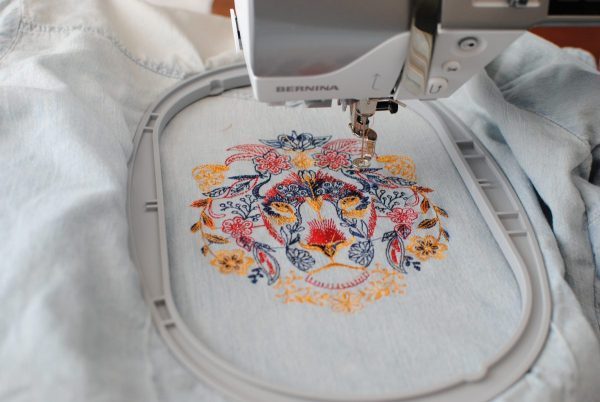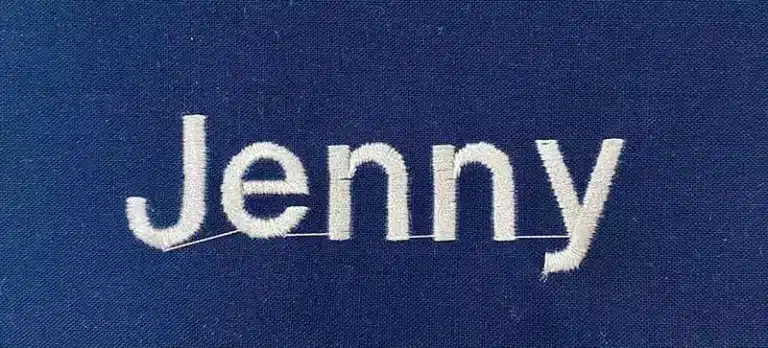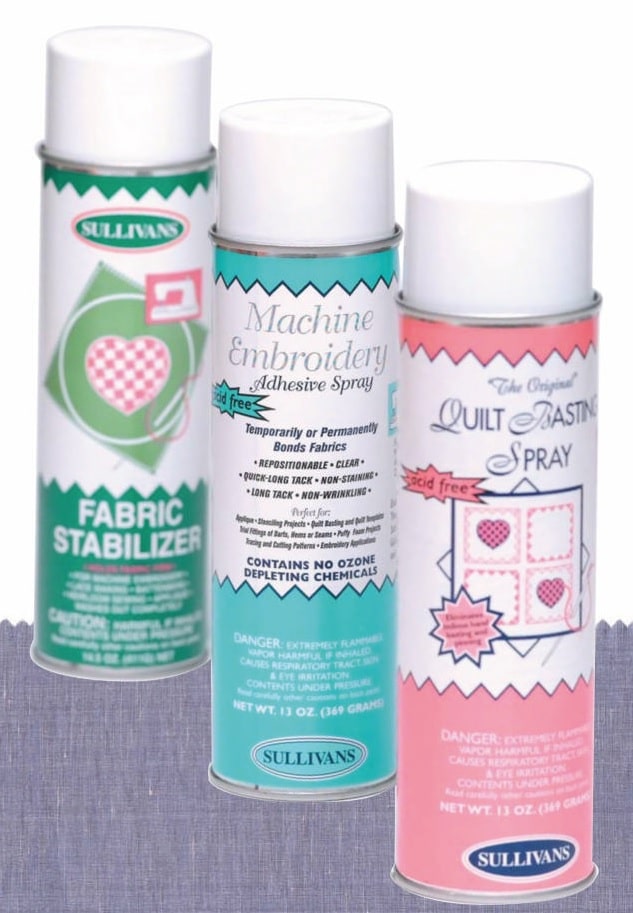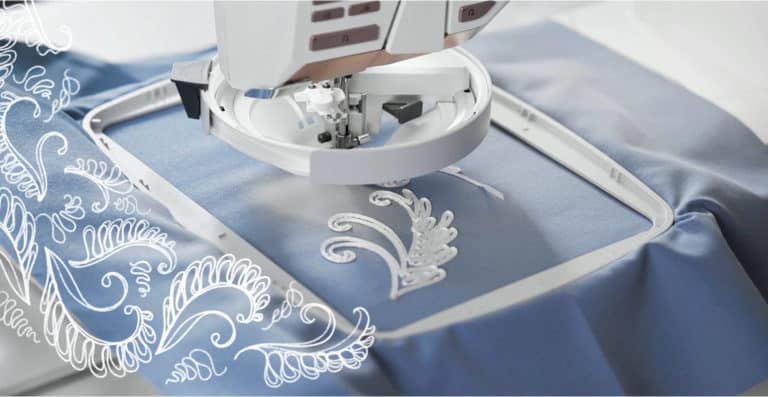Sewing interruptions can be caused by many factors, however the most common
causes include the following:
• Needle Thread Breakage or Pull-out – not picking up at the beginning of a
stitch pattern
• Bobbin Thread Run-out or Thread Pick-Up – not picking up at the
beginning of a stitch pattern
• Improper Thread Trimming
• Thread break detector stoppage
In order to minimize interruptions during the stitching of complex embroidery
patterns, the following vital elements must work together during the embroidery
process. These vital elements include:
• Proper Digitizing for the fabric and pattern being sewn
• Proper Embroidery Machine Maintenance and Settings
• Correct Backings and/or Toppings for the Application
• Proper Needle Type and Size
• Quality Embroidery Threads
We will look at each of these elements and discuss potential causes for excessive
sewing interruptions.
A. INTERRUPTIONS DUE TO NEEDLE THREAD BREAK
Digitizing Causes:
• Improper cornering with too many stitches in the same location
• Not using appropriate underlay stitches that help minimize flagging during
the rest of the stitch pattern
• Density properties too high within designs that layer many colors of
thread
• Not using Tie-In Stitches at beginning of thread changes
• Not using Short Stitches at the end of a stitching cycle
Digitizing Solutions:
• Try to minimize the stitch density at any one point.
• Reduce density properties as you build up layers of embroidery
• On lettering, use your “short-stitch” function
• Use appropriate underlay stitches that help minimize flagging
• Use slower speed “Tie-In” Stitches at beginning of thread changes
• Use slower speed “Tie-Off” Stitches at the end of a stitching cycle. Try
not to put these stitches in the exact location.
Embroidery Machine Causes:
• Lack of preventive maintenance
o Excessive lint and dirt in the machine
o Machine needing to be lubricated
• Worn machine parts
o Normal wear and tear of sewing machine
• Burr on hook
• Bobbin plate is scratched
• Needle hole in needle plate enlarged causing excessive
flagging
• Machine thread tensions not set correctly
o Tension too tight for the thread and application
o Tension too loose not allowing the machine too pull the stitch up
properly causing a “birds-nest” of excessive thread.
• Machine out of adjustment
o Needle bar height
o Hook Settings – Timing and position to needle
o Foot or counter-presser not set correctly
o Take-up Spring not set correctly
• Thread trimmer
o Trimmer not cutting cleanly
o Tension release not working properly causing the thread to pull
back out of the needle when the thread is trimmed
o Thread caught in trimmers
Embroidery Machine Solutions:
• Develop a good preventive maintenance program
o Blow-off the machines everyday
o Make sure the machines are properly lubricated on a regular basis.
o Pull machines out of production to inspect the machines on a
regular basis
• Replace all worn machine parts
• Inspect the hooks for excessive wear
• Check for excessive shake between the basket and
hook base and replace the hook if necessary
• Check the needle guarding surface in the bobbin case
holder to make sure it has not been worn and allow
the hook point to hit the needle.
• Remove burrs or sharp edges from the hook point
• Polish the bobbin plate to make sure it is smooth
• Replace the needle plate if the needle hole has been
enlarged.
• Sharpen and replace the thread trimming knives.
• Make sure the Embroidery Machines are adjusted properly
o Correct needle bar height
o Proper hook settings – Timing and position to needle
o Make sure the needle centers in the counter-presser (foot) and it is
adjusted the correct height to minimize flagging.
o Set the Take-up Spring so that it is working properly
• Set the Machine thread tensions correctly
o On satin stitches, check for the 2/3 – 1/3 rule on the underside of
the stitching.
o Make sure there are no “birds-nests” on the back side of the stitch
pattern. If so, try tightening the needle thread tension.
• Make sure the Thread trimmer is operating properly
o The trimming knifes and sharp and trim the needle and bobbin
thread cleanly.
o The tension release mechanism is working properly so a needle
thread tail is left allowing it to be picked up at the beginning of the
next stitching cycle.
.Hooping, Adhesive and Backing Causes:
• Hoop not loaded properly
• Adhesive not holding the fabric properly where a hoop is not used
• Wrong backing for the application allowing excessive flagging
• Backing too thick putting too much stress on the thread
Hooping, Adhesive and Backing Solutions:
• If hoops are used, make sure they fit properly into the pantograph. Use
the smallest hoop possible for the pattern to minimize flagging.
• If an adhesive tape is used, make sure it holds the fabric firmly in place to
minimize flagging.
• Note: flagging is when the material moves up with the needle minimizing
the size of the needle loop which can cause excessive skips and thread
breakage.
• Use a quality backing that provides dimensional stability in all directions of
the stitch pattern.
Needle Causes:
• Needles not installed in the machine correctly – pushed all the way up in
the needle bar with the scarf facing the stitch forming devise.
• Incorrect needle size / thread size relationship – needle to small for the
application
• Bent or burred needles
• Lint / Adhesive build up on the needles
• Poor needle quality – buying cheap needles
Needle Solutions:
• Train the sewing operators how to properly install the Needles in the
machine with the scarf facing the stitch forming devise.
• Use the correct needle for the thread being used.
For a #122 Tkt 40 size thread, we recommend a Size nm 70
needle.
For a Tkt 40 Metallic thread, we recommend us a Size nm 80
needle.
• Check the needles at regular intervals to make sure they are not bent or
burred, and there is not lint or adhesive build-up on the needle.
• Use quality needles from a reputable needle supplier
Thread Causes:
• Low tenacity thread – too weak
• Excessive elongation – causing poor loop formation
• Excessive knots or major imperfections in the thread
• Improper Twist – thread unraveling prematurely causing an unravel-type
thread break
• Thread not lubricated properly
o Causing Inconsistent frictional characteristics
o Allowing the thread to melt due to needle heat
• Wrong needle size for the weight of thread is being used
• Thread not stored properly
o Damaged cone affecting thread pay-off
o Thread dirty or bruised
o Poor pay-off the cone
• Thread picking up residue from Adhesive
Thread Solutions:
• Use a high tenacity quality embroidery thread from a reputable global
thread company.
• Use the correct size thread for the embroidery application.
• Make sure the thread stored properly
o Using A&E/RA special “snap spool” feature to hold the loose end
o On storage bins or in the original shipping container
B. INTERRUPTIONS DUE TO BOBBIN THREAD
Causes:
• Poor quality pre-wound bobbins
o Poor quality wind
o Size – diameter, thickness, core
• Inconsistent bobbin wind – machine wound bobbins
• Improper bobbin thread tension – too tight or too loose
• Bobbin thread run-out
o Inconsistent yardage from bobbin to bobbin
• Bobbin over-spin
o Causing a short tail that cannot be picked up by the needle thread
during the beginning of the next stitching cycle
Solutions:
• Use a quality bobbin thread. The needle thread will sew only as well as
the bottom thread.
• Use quality filament or spun pre-wound bobbins from A&E/RA that have
consistent yardage.
• Adjust the bobbin with a firm but not too tight of thread tension.
• Use A&E/RA’s special pre-wound magnetic bobbins that help to minimize
bobbin overspin.
C. MACHINE STOP ISSUES
Causes:
• Thread-Stop Detector
o Thread-stop detector defective
o Detector stops machine prematurely due to inconsistencies in the
thread
Poor yarn quality
Inconsistent thread lubricant
o Detector stops machine prematurely
Burr or excessive wear of the hook causing erratic pull off
the cone
o Detector stops machine prematurely due to poor digitizing
Excessively long stitches
Multiple direction changes
Solutions:
• Make sure the thread-stop detector is working properly.
• Observe the thread pulling into the machine to see that it is pulling
uniformly and not in a jerky motion. If it is pulling erratically, check the
following:
o Excessive hook wear so that the bobbin case holder is not gliding
smoothly in the hook base.
o The hook contact surfaces for burrs or scratches
• If it is pulling through the machine erratically only during certain portions
of the pattern, observe if this timing is consistent from machine to
machine and one multiple patterns. This may indicate that the pattern
needs to be re-digitized to correct this situation.
• Use a quality thread that pulls consistently through the embroidery
machine and will not cause premature detector stops.
Related Posts
Discover relevant articles, tutorials, and tips to improve your skills and explore new techniques.
Stay inspired and connected to our embroidery community.







Thank you for tthe auspicious writeup. It iin act used to be a leisure
account it. Look advanced to more introduced agreeable from you!
By the way, how could we keep up a correspondence?
Appreciate this post. Let me try it out.
Great post! We will be linking to this great article on our website.
Keep up the great writing.
You could certainly see your skills in the article you write.
The world hopes for more passionate writers such as you who aren’t afraid to
say how they believe. All the time go after your heart.